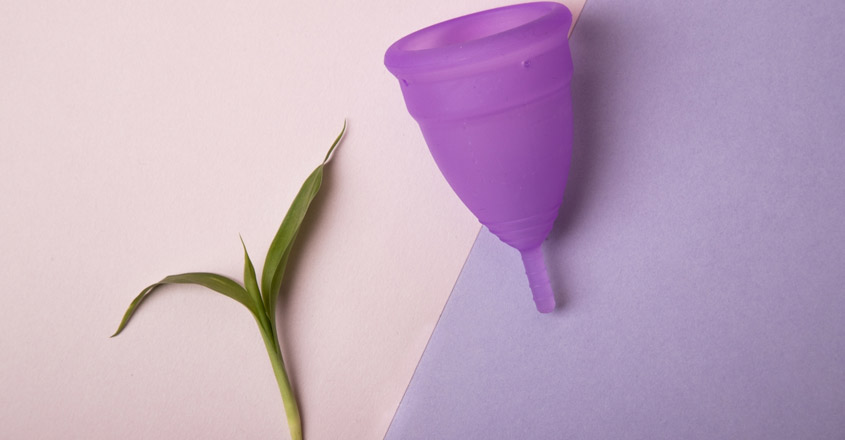Menstrual Cups are reused tampon alternatives. They’re silicone cups worn inside the opening of the vagina to store period blood rather than absorb it as tampon does. Today, there seems to be a variety of menstrual cups available. These are available in a multitude of shapes, sizes, colors, and stiffness. It’s difficult to predict what will and won’t work for you.
Tampons and pads cannot store as much liquid as menstrual cups. They may store twice the amount of liquid as sanitary napkins and tampons. They don’t need to be changed as often as pads do. They are also beneficial to the environment.
Here are a few things to think about to make sure your menstrual cup is right for you.
Menstrual cup V/S Tampons
Menstrual cups are made of rubber, silicone, or soft plastic and are fashioned like small bells or bowls. The cup is worn inside your vaginal opening and catches menstrual blood.
Tampons are small cotton plugs that fit within your vaginal opening and absorb menstrual blood. Some tampons include an applicator that makes it easier to insert the tampon. Tampons feature a string at the end that makes it easy to draw them out.
Using a menstrual cup
To use a menstrual cup, bend that into a C shape and then put it into your vagina, tilting it back towards the base of the spine. The cup should be as low as possible inside your vaginal canal, but the base should be fully inserted. When the cup is entirely unfolded, it will spring open, providing a gentle suction, which stops leakage. Use your fingers to inspect if it is fully unfolded, twist or spin if necessary, and don’t hurry.
Although a menstrual cup can be used for up to 12 hours, many women prefer to empty their cups in the morning and evening. When it’s time to replace your cup, carefully pull the stems of the cup downward once you can feel and hold the cup’s base. To relieve the suction, pinch the base and gently remove it.
When keeping your cup each month, clean it at the completion of your period. Wash and sterilize your cup in a skillet or saucepan of water. 3 minutes at a simmering If you don’t want to use a pot to disinfect, you can boil in the microwave or oven.
Choosing a Menstrual Cup
There are some other things you need to consider first.
Cervical Height
When picking a menstrual cup, one of the most crucial things to keep in mind is the height of your cervix. Trying to prop one of your legs up on a table or the washroom bench, rise up and take the pose often recommended for using a tampon. Stick your finger into your vaginal canal and see how far up you have to go to feel your cervix.
If you can just get your first knuckle to touch it. It is a Low.
If you can feel your cervix with your finger inserted up to the second knuckle. It’s a Medium level.
You have a high cervix if your finger is all the way in and you can’t feel your cervix. It’s at an all-time high.
A longer cup is better for you if you have a higher cervix. When you wear a short menstrual cup, it can ride up throughout the day and be hard to remove because it is longer in your vaginal canal.
If you have a lower cervix, a shorter cup is good for you.
Flow
The Menstrual Cup Tiny is designed to accommodate a Light to Medium Flow; a menstrual cup with a capacity of 25ml can be used for up to 6 hours! Because pads don’t normally come with absorbent ratings, it’s more difficult to predict your flow with them. Follow your gut and make an educated approximation depending on how frequently you need to change your pad.
Firmness
If you use a menstrual cup and find that you need to urinate more frequently than usual or that you don’t completely empty your bladder when you do, you may have a sensitive bladder. While using a cup, you may feel some discomfort, soreness, or even cramps.
Using a soft cup will reduce the amount of applied pressure to those sensitive spots. Trying a cup with a different shape than the one you’re now using may also change the pressure to a place where you’re not having any problems.
Grade
It’s worth noting that just because a cup says it’s made of medical-grade silicone doesn’t guarantee it’s been evaluated for usage inside the body. Most medical-grade silicones are at least Class VI certified, and materials authorized as Class V and VI can be termed medical grade.
Benefits
- Menstrual cups have a number of advantages, one of which is that they are a more environmentally responsible option than pads and tampons.
- You can utilize a variety of them on a regular basis, on different days and at different times of the month.
- It’s reusable and also more cost-effective than other menstruation products.
- There’s less risk of toxic absorption.









